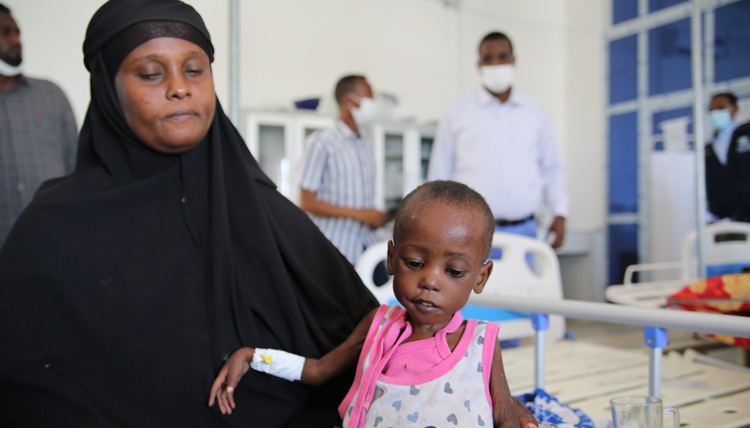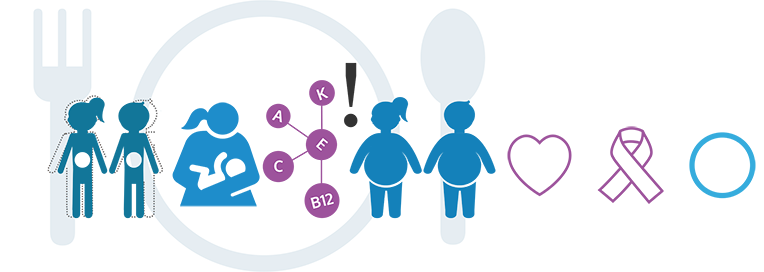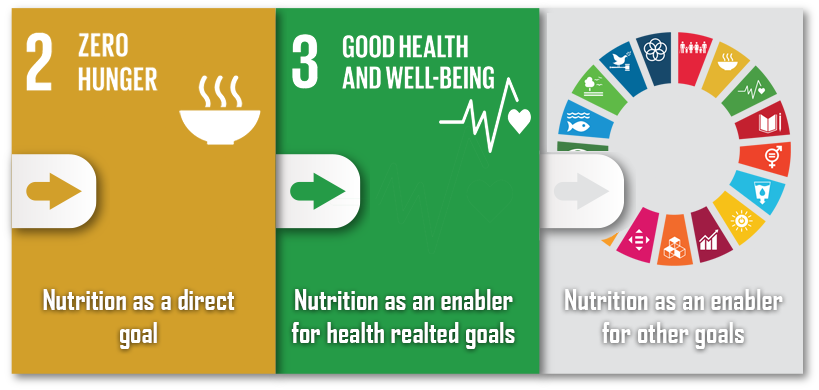Malnutrition in all its forms

Noncommunicable diseases are now responsible for two thirds (62%) of deaths in the Region, and unhealthy diets – along with physical inactivity – are key contributors to this burden.
At present, many of our countries suffer from a double burden of malnutrition, which consists of both undernutrition and overweight and obesity, as well as diet-related noncommunicable diseases. Despite some progress, poor maternal, infant, young child and adolescent nutrition continues to threaten the health and development of women, adolescents and children in the Region. We are working with countries to improve the nutritional status of these groups to reduce disease and prevent premature death, and maximize the development potential of children and the societies in which they live.

Combating malnutrition in all its forms is one of the greatest global health challenges. The double burden of malnutrition offers a unique and important opportunity for integrated action on malnutrition in all its forms. Addressing this double burden of malnutrition is key to achieving the Sustainable Development Goals, in particular, Goal 2 (end hunger, achieve food security and improved nutrition and promote sustainable agriculture) and Target 3.4 (reduce mortality from noncommunicable diseases and promote mental health), and the Commitments of the Rome Declaration on Nutrition, within the United Nations Decade of Action on Nutrition.

Defining malnutrition
It addresses 3 broad groups of conditions
Undernutrition
which includes wasting (low weight-for-height), stunting (low height-for-age), underweight (low weight-for-age), and deficiencies in vitamins and minerals.
Undernutrition makes children more vulnerable to disease and death.
Wasting (low weight-for-height) usually indicates recent and severe weight loss, because a person has not had enough food to eat and/or they have had an infectious disease, such as diarrhoea, which has caused them to lose weight. A young child who is moderately or severely wasted has an increased risk of death, but treatment is possible.
Stunting (low height-for-age) is the result of chronic or recurrent undernutrition, usually associated with poor socioeconomic conditions, poor maternal health and nutrition, frequent illness, and/or inappropriate infant and young child feeding and care in early life. Stunting holds children back from reaching their physical and cognitive potential.
Underweight (low weight-for-age) children may be stunted, wasted, or both.
Micronutrient-related malnutrition
which includes micronutrient deficiencies (a lack of important vitamins and minerals) or micronutrient excess.

Micronutrients enable the body to produce enzymes, hormones, and other substances that are essential for proper growth and development.
Iodine, vitamin A, and iron are the most important in global public health terms. Their deficiency represents a major threat to the health and development of populations worldwide, particularly children and pregnant women in low-income countries.
Overweight, obesity and diet-related noncommunicable diseases
(such as heart disease, stroke, diabetes and some cancers).

Overweight and obesity is when a person is too heavy for their height.
Abnormal or excessive fat accumulation can impair health.
Body mass index (BMI) is an index of weight-for-height commonly used to classify overweight and obesity. It is defined as a person’s weight in kilograms divided by the square of their height in meters (kg/m²). In adults, overweight is defined as a BMI of 25 or more, whereas obesity is a BMI of 30 or more.
Overweight and obesity result from an imbalance between energy consumed (too much) and energy expended (too little).
People everywhere are consuming foods and drinks that are more energy-dense (high in sugars and fats), and engaging in less physical activity.
Diet-related noncommunicable diseases include cardiovascular diseases (such as heart attacks and stroke, and often linked with high blood pressure), certain cancers and diabetes.
Unhealthy diets and poor nutrition are among the top risk factors for these diseases in WHO’s Eastern Mediterranean Region.
The double burden of malnutrition
The double burden of malnutrition is characterised by the co-existence of undernutrition along with overweight and obesity, or diet-related noncommunicable diseases, within individuals, households and populations, and across the life course. This double burden of malnutrition can exist at the:
individual level, for example, obesity with deficiency of one or various vitamins and minerals, or overweight in an adult who was stunted during childhood;
household level, when a mother may be overweight or anaemic and a child or grandparent is underweight; and
population level, where there is a prevalence of both undernutrition and overweight in the same community, nation or region.
Moreover, the relationship between undernutrition and overweight and obesity is more than a co-existence. Undernutrition early in life – and even in utero – may predispose to overweight and noncommunicable diseases such as diabetes and heart disease later in life. Overweight in mothers is also associated with overweight and obesity in their offspring. Rapid weight gain early in life may predispose to long-term weight excess. These are just some of the examples of biological mechanisms, which along with environmental and social influences, are increasingly understood as important drivers in the global burden of malnutrition across the life course.
This double burden of malnutrition offers a unique and important opportunity for integrated action on malnutrition in all its forms. Addressing the double burden of malnutrition is key to achieving the Sustainable Development Goals, in particular, Goal 2 (end hunger, achieve food security and improved nutrition and promote sustainable agriculture) and Target 3.4 (reduce mortality from noncommunicable diseases and promote mental health), and the Commitments of the Rome Declaration on Nutrition, within the United Nations Decade of Action on Nutrition.
Data from the Region
Undernutrition

Undernutrition was an underlying cause in 45% of deaths of children under-5 years of age in 2015, and nearly one in five (19.3%) babies born in the Region are low birth weight.
There are still large numbers of children who are too short for their age (stunted) because they are chronically undernourished or who are too thin (wasted) because of acute undernutrition.
The prevalence of stunting has declined since 2010 but continues to be high in the Region. In 2018, the growth of 20.2 million children, nearly one in four (24.7%), was stunted.
Across the Region, 6.4 million children (7.8%) were too thin for their height (moderately or severely wasted) and, of these, 2.7 million were severely wasted.
Micronutrient-related malnutrition
Many children also continue to face the “hidden hunger” of vitamin or mineral deficiencies.
Between 7.4% and 88% of children under 5 and between 7.4% and 40.9% of school-aged children have anaemia.
Prevalence of vitamin A deficiency among children under 5 is estimated to affect 22% of children in the Region and ranges from 0.5% to 72.9%.
Micronutrient malnutrition in adults also continues to be a challenge, particularly among women of reproductive age, where it contributes to poor health outcomes for women and to the inter-generational cycle of malnutrition.
Maternal short stature and iron deficiency anaemia contributed to 20% of maternal deaths.
Anaemia among women of reproductive age (15‒49 years) ranged from 20.0% to 50.4% in countries of the Region.

Overweight, obesity and diet-related noncommunicable diseases
![]()
Approximately 49% of adults are overweight or obese, with higher rates among women (53%) compared to men (more than 45%).
8% of school-aged children or adolescents are overweight or obese – which poses serious implications for their health and well-being throughout the life course.
The prevalence of child overweight in the lower-middle income countries of the Region is twice as high as in other lower-middle income countries in the world.
Overweight and obesity is closely linked to physical inactivity and unhealthy diet, with the Region having a high prevalence of physical inactivity in adults (35%) in 2016, the second highest regional prevalence rate in the world.
Noncommunicable diseases are responsible for two thirds (62%) of deaths in the Region, and unhealthy diets – along with physical inactivity – are key contributors to this burden.
The Region has seen the greatest increase in the prevalence of diabetes and has the highest prevalence rate globally, with 14% of the population affected.
More than two in five deaths (45%) are attributed to cardiovascular diseases, and these rates are also among the highest in the world.
Combatting malnutrition in all its forms
Every country in our Region is affected by one or more forms of malnutrition. Women, infants, children and adolescents are at particular risk of malnutrition.
Poverty amplifies the risk of, and risks from, malnutrition. People who are poor are more likely to be affected by different forms of malnutrition. Also, malnutrition increases health care costs, reduces productivity, and slows economic growth, which can perpetuate a cycle of poverty and ill-health.
United Nations Decade of Action on Nutrition
Combating malnutrition in all its forms is one of the greatest global health challenges. On 1 April 2016, the United Nations General Assembly proclaimed 2016–2025 the United Nations Decade of Action on Nutrition. The Decade is an unprecedented opportunity for addressing all forms of malnutrition. It sets a concrete timeline for implementation of the commitments made at the Second International Conference on Nutrition to meet a set of global nutrition targets and diet-related noncommunicable disease targets by 2025, as well as relevant targets in the Agenda for Sustainable Development by 2030—in particular, Sustainable Development Goal 2 (end hunger, achieve food security and improved nutrition and promote sustainable agriculture) and Sustainable Development Goal 3 (ensure healthy lives and promote wellbeing for all at all ages).
Led by WHO and the Food and Agriculture Organization of the United Nations, the United Nations Decade of Action on Nutrition calls for policy action across 6 key areas:
creating sustainable, resilient food systems for healthy diets;
providing social protection and nutrition-related education for all;
aligning health systems to nutrition needs, and providing universal coverage of essential nutrition interventions;
ensuring that trade and investment policies improve nutrition;
building safe and supportive environments for nutrition at all ages; and
strengthening and promoting nutrition governance and accountability, everywhere.
Strategy on nutrition for the Eastern Mediterranean Region 2020–2030
We are providing countries with technical support to develop strategies and support implementation of policies to improve nutrition in the Region, achieve food security and eliminate malnutrition in all its forms. Much more progress is still needed to meet globally agreed targets. It is clear that current food systems are failing to deliver nutrition for all and that radical transformation of food systems is needed to improve access to healthy, sustainable diets.
Comprehensive, multisectoral action is key to addressing malnutrition in all its forms across the Region. We developed this comprehensive regional nutrition strategy for 2020–2030 to establish a framework for efforts to reach agreed targets on nutrition, diet-related noncommunicable diseases and sustainable development, as well as to guide implementation of the remainder of the United Nations Decade of Action on Nutrition in the Region. The vision and overall objective of the nutrition strategy are outlined below.


Related links
Strategy on nutrition for the Eastern Mediterranean Region 2020–2030
Sustainable Development Goal 2: Zero hunger
Sustainable Development Goal 3: Ensure healthy lives and promote well-being for all at all ages


